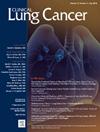Prognostic Analysis of Pathological Stage I Lung Adenocarcinoma Harboring Major EGFR Mutations
IF 3.3
3区 医学
Q2 ONCOLOGY
引用次数: 0
Abstract
Background
While Epidermal growth factor receptor (EGFR) mutation-positive lung adenocarcinoma (LUAD) has favorable outcomes with targeted therapy, early-stage prognosis remains influenced by pathological factors and central nervous system (CNS) recurrence. The study aimed to clarify prognostic factors in pathological stage (pStage) I EGFR mutation-positive LUAD.
Methods
Between 2015 and 2018, 2,191 pStage I LUAD cases with known EGFR status (excluding EGFR testing after recurrence) who received anatomical resection were included from multiple institutions in Japan. Univariate and multivariate analyses of disease-free survival (DFS) and overall survival (OS) were performed.
Results
1,073 (49.0%) cases harbored EGFR mutations, including 419 (19.1%) with 19del and 529 (24.1%) with L858R. In cases with major EGFR mutation (n = 948), multivariate analysis showed that the absence of noninvasive area (NIA) (hazard ratio [HR]: 1.778, 95% confidence interval [CI]: 1.174-2.692, P = .0065), pStage (IA2 vs. IA1, HR: 2.079, 95% CI: 1.129-3.827, P = .0345; IA3 vs. IA1, HR: 4.009, 95% CI: 2.088-7.696, P = .0001; IB vs. IA1, HR: 5.280, 95% CI: 2.871-9.709, P < .0001), and presence of lymphatic invasion (HR: 1.855, 95% CI: 1.103-3.119, P = .0197) were independent predictors of shorter DFS, and only advanced pStage was an independent predictor of CNS recurrence (relative risk for pStage IA3 or more: 9.729, P < .0001).
Conclusion
In EGFR mutation-positive pStage I LUAD, those without NIA, with higher pStage and lymphatic invasion were independent predictive factors for DFS, and pStage ≥ IA3 was an independent predictor of CNS recurrence.
含有主要EGFR突变的病理性I期肺腺癌的预后分析。
背景:虽然表皮生长因子受体(EGFR)突变阳性的肺腺癌(LUAD)通过靶向治疗具有良好的预后,但早期预后仍受病理因素和中枢神经系统(CNS)复发的影响。本研究旨在阐明病理期(pStage) I EGFR突变阳性LUAD的预后因素。方法:在2015年至2018年期间,来自日本多家机构的2191例已知EGFR状态(不包括复发后的EGFR检测)接受解剖切除的pi期LUAD患者。对无病生存期(DFS)和总生存期(OS)进行单因素和多因素分析。结果:EGFR突变1073例(49.0%),其中19del突变419例(19.1%),L858R突变529例(24.1%)。多因素分析显示,在EGFR重大突变病例(n = 948)中,无创区缺失(NIA)(风险比[HR]: 1.778, 95%可信区间[CI]: 1.174-2.692, P = 0.0065)、pStage (IA2 vs IA1, HR: 2.079, 95% CI: 1.129-3.827, P = 0.0345;IA3 vs. IA1, HR: 4.009, 95% CI: 2.088 ~ 7.696, P = 0.0001;IB vs IA1, HR: 5.280, 95% CI: 2.871-9.709, P < 0.0001)和淋巴浸润的存在(HR: 1.855, 95% CI: 1.103-3.119, P = 0.0197)是较短DFS的独立预测因子,只有pStage晚期是CNS复发的独立预测因子(pStage IA3或以上的相对风险:9.729,P < 0.0001)。结论:在EGFR突变阳性的pStage I LUAD中,无NIA、pStage较高和淋巴浸润是DFS的独立预测因素,pStage≥IA3是CNS复发的独立预测因素。
本文章由计算机程序翻译,如有差异,请以英文原文为准。
求助全文
约1分钟内获得全文
求助全文
来源期刊

Clinical lung cancer
医学-肿瘤学
CiteScore
7.00
自引率
2.80%
发文量
159
审稿时长
24 days
期刊介绍:
Clinical Lung Cancer is a peer-reviewed bimonthly journal that publishes original articles describing various aspects of clinical and translational research of lung cancer. Clinical Lung Cancer is devoted to articles on detection, diagnosis, prevention, and treatment of lung cancer. The main emphasis is on recent scientific developments in all areas related to lung cancer. Specific areas of interest include clinical research and mechanistic approaches; drug sensitivity and resistance; gene and antisense therapy; pathology, markers, and prognostic indicators; chemoprevention strategies; multimodality therapy; and integration of various approaches.
 求助内容:
求助内容: 应助结果提醒方式:
应助结果提醒方式:


